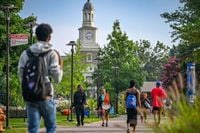In the halls of Morgan State University, the name Dr. Earl S. Richardson resonates with a power that few leaders in higher education ever achieve. His passing on September 13, 2025, at the age of 81, marks not just the end of an era for one of Maryland’s most prominent historically Black colleges and universities (HBCUs), but also a moment of reckoning for advocates of educational equity and justice across the nation.
Dr. Richardson’s tenure as president of Morgan State, from 1984 to 2010, was nothing short of transformative. According to NPR and CBS Baltimore, he spearheaded the university’s evolution from a regional institution grappling with underfunding and crumbling facilities into a beacon of academic excellence and opportunity for Black students. His vision was rooted in a deep belief in the power of public education to unlock human potential, especially for those historically left behind.
“Morgan State would not be where it is today without Dr. Richardson,” Baltimore Mayor Brandon S. Scott stated, reflecting on the leader’s profound impact on both the university and the city. “Under his leadership, Morgan grew in every sense of the word—from enrollment to degree offerings to physical expansion of the campus. All of that progress brought new students and new investments to Baltimore, helping to drive our own citywide growth.”
Perhaps Dr. Richardson’s most visible legacy is the creation of Morgan State’s School of Engineering, an initiative that, as reported by Black Enterprise, dramatically reshaped access to STEM fields for generations of Black students in Maryland and nationwide. His recruitment of Dr. Eugene M. DeLoatch as the founding dean—a move described as visionary by university colleagues—helped Morgan become the leading producer of Black engineers in the United States. This wasn’t just about new buildings or programs; it was about bridging equity, innovation, and community advancement in ways that reverberated far beyond campus.
Yet Richardson’s leadership extended well beyond the boundaries of Morgan State. He was a driving force in the 15-year legal battle that ultimately secured $577 million in supplemental funding for Maryland’s HBCUs, a struggle that many compared to the landmark “Brown v. Board of Education” Supreme Court case. According to NPR, Richardson’s expertise and institutional knowledge made him an indispensable figure in the lawsuit, even though, as a state employee, he could not officially sue Maryland himself. Through the Coalition for Equity and Excellence in Maryland Higher Education Inc., he served as an expert witness and strategic guide, ensuring that the fight for fairness in higher education funding would not be ignored.
The roots of this struggle can be traced to the early years of Richardson’s presidency. In 1990, student protests erupted at Morgan State over dilapidated campus conditions. Initially, the administration was the target of frustration, but as former protestor Edwin Johnson recalled, Richardson helped students redirect their anger toward the true source of the problem: chronic underfunding by the state government. “We originally were protesting against Morgan’s administration,” Johnson told NPR. “But then after we dig and do a little research, we find out it’s not our administration, but it’s the governor down in Annapolis that isn’t equipping the administration with what they need to appropriately run the school.”
This redirection of focus, and the subsequent 34-mile march to the Capitol in Annapolis, marked a turning point. Richardson’s leadership not only galvanized the campus but also brought national attention to the inequities faced by Black institutions in Maryland. The victory that followed—both in the courtroom and on campus—became known as “Morgan’s Renaissance,” or, as some affectionately called it, “Richardson’s Renaissance.” Under his stewardship, Morgan State expanded its campus, built new schools of architecture and social work, and more than doubled its enrollment.
Recognition for Dr. Richardson’s achievements poured in from all corners. He received the Maryland Senate’s prestigious Citizenship Award and was honored by President Barack Obama for his outstanding service to American higher education. In 2008, Morgan State dedicated a 222,000-square-foot library in his name, a lasting tribute to his vision and tenacity.
But accolades alone do not capture the depth of Dr. Richardson’s influence. As Dr. Adriel A. Hilton, a prominent HBCU advocate and academic leader, wrote in Diverse: Issues In Higher Education, Richardson’s passing is not merely a moment for reflection but a call to action. “He was a master builder in every sense of the term. He saw potential where others saw limits. He saw the value of HBCUs not as a second option but as essential to the American higher education ecosystem,” Hilton wrote. “His leadership challenged a state system that had long underfunded and undervalued Black institutions.”
Hilton recalled a personal encounter with Richardson, who pulled him aside after a formal event and simply said, “Hilton, continue on.” Those words, Hilton explained, were not just encouragement—they were a charge to continue the fight for equity and justice in higher education. “Dr. Richardson did not just leave a legacy. He left a blueprint. The question is whether we will follow it.”
Richardson’s approach to leadership was marked by a rare blend of wisdom, grace, and fierce advocacy. He led with what Hilton described as “love that was active, strategic, and unapologetic, demanding equity and justice rather than charity.” For Richardson, education was never an abstract ideal; it was an urgent, necessary tool for justice and community transformation. He never lost sight of the students who came from under-resourced backgrounds, and he refused to accept a future that mirrored the inequities of the past.
David S. Wilson, Morgan State’s current president, underscored the enduring significance of Richardson’s work. “Morgan is stronger today because of Earl S. Richardson, and for that, we are eternally grateful,” Wilson wrote in a press release. He called on the community to “honor his extraordinary contributions by rededicating ourselves to the ideals he championed and the mission he so faithfully advanced.”
Maryland Governor Wes Moore echoed these sentiments, calling Richardson “a pillar of Maryland and the Morgan State University Community.” He added, “Dr. Richardson dedicated his life to the education of young Marylanders—our home is stronger because of his work.”
As the academic world mourns Dr. Richardson’s passing, the challenge he leaves behind is clear: to build on his foundation with urgency and vision. His life’s work, rooted in the belief that HBCUs are not just important but essential, continues to inspire a new generation of educators, students, and leaders. The blueprint is there for all to see. The question, as Hilton and others have asked, is whether today’s leaders will have the courage and commitment to follow it.
Dr. Richardson’s story is not one of ease, but of struggle, persistence, and vision. He faced resistance and doubt, yet pressed on—creating new possibilities for generations of Black students who might otherwise have been left behind. His spirit, woven into the very fabric of Morgan State, endures as a call to action for all who believe in the transformative power of education.




